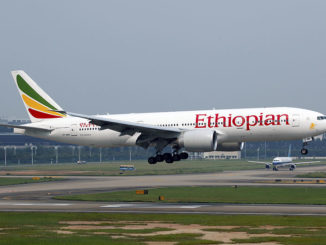
Following the Ethiopian Airlines plane crash on March 10th, which killed all 157 people on board, both ABC News Online and BuzzFeed News produced coverage of the incident. Through a comparison of ABC News Online and BuzzFeed News’ stories, we can reveal differences between both publications and the effectiveness of each story’s delivery.
ABC News Online – Background
The Australian Broadcasting Commission (ABC) is Australia’s leading governmental public broadcasting service, launched in 1932 (ABC, 2019). While managed by a board of directors, the ABC was established under the federal ABC Act (1983) and is owned by the government (ABC, 2019). With the ABC as an umbrella for a wide range of sites and services, abc.net.au is the ABC’s digital website, launched in August 1995, with its official news service site being abc.net.au/news (ABC, 2019).
As a public service broadcaster, ABC News does not have a paywall. ABC News has established a reputation as a transparent, professional news service which holds itself accountable and undertakes reviews on its own media practices through federal legislation and programmes like Media Watch. According to the ABC Act (1983), the ABC aims to “provide…innovative and comprehensive broadcasting services of a high standard” (Australian Government, 2019). Like most Australian legacy media publications, the ABC operates under the self-regulatory standards set out by the Australian Communications and Media Authority (ACMA) and has several internal policies which guide the publication (ABC, 2019).
Annual data from 2017 – 2018 revealed ABC News Online reached an average of 7.6 million users per month, around 37% of the population (ABC, 2018, p. 74). On average, “there were 9.5 million domestic and international visitors each week to ABC websites and apps” that year (ABC, 2018, p. 74). ABC News maintains the largest social media audience of any Australian news organisation (ABC, 2018, p. 74). In a survey of adults aged 18 – 75, 82% were found to trust the information the ABC provides (ABC, 2018, p. 58).
BuzzFeed News – Background
BuzzFeed News is the official news branch of BuzzFeed, a digital-born media start-up company founded by Jonah Peretti in 2006, based in New York City with offices around the world (Greenwood, 2017, p. 45); BuzzFeed News officially launched in 2012 (BuzzFeed News, 2018). There are no paywalls restricting access to articles, however there is an option to support BuzzFeed News with a paid monthly or yearly membership. The BuzzFeed model “concentrates on pushing its stories out across social platforms built by others”, and as such values visits to an individual story rather than visits to the site overall (Greenwood, 2017, p. 45). “Social lift”, its self-described measure of success, shows how effective and engaging a piece has been with the ultimate aim being that it is shared by consumers (Greenwood, 2017, p. 48). Subsequently, BuzzFeed has built a reputation for its blend of hard news and pop-culture-driven, viral, entertainment-based media content, however the “big wall between commercial and editorial” (Greenwood, 2017, p. 49) ensures BuzzFeed News is insulated from BuzzFeed overall and can build a “premium journalism reputation” (Greenwood, 2017, p. 48).
BuzzFeed News receives over 21 million visitors per month, with 74% based in the US; its global audience is over 650 million (Quantcast, 2019). Visitors are mostly female, at upwards of 70% per month, with most in the Millennial 25 – 34 age-bracket (Quantcast, 2019). 74% of recent monthly visitors were Caucasian, 54% had no kids within their households, and 46% had an annual wage of $50,000 or under (Quantcast, 2019). Overwhelmingly, monthly data shows a consistent pattern of mobile-based visits to BuzzFeed News over desktop use (Quantcast, 2019).
ABC News Online – Coverage
ABC News Online published their coverage of the Ethiopian Airlines crash on March 10th, with the latest update on March 11th at 12:09pm. Written in the inverted-pyramid style (Bradshaw & Rohumaa, 2017, p. 80), this piece presents a professional and cohesive account of the incident. The article’s chief focus is the victims and their affected families, and the involvement of Boeing 737 MAX aircrafts in recent major crashes. The ABC offers an arguably richer, more expanded version of the incident than BuzzFeed News, including speculation on how and why the aircraft had crashed and details on the nationalities of the victims, interviews with their families, and any Australian involvement in subsequent aid efforts. Accurate, detailed information from credible sources such as “Swedish flight-tracking website flightradar24”, Ethiopian Airlines’ official Twitter page, and the “Planespotters civil aviation database” are provided (ABC, “Ethiopian Airlines flight to Nairobi crashes with ‘no survivors’ of 157 people aboard”, 2019).
The headline is search engine optimised, including relevant and important keywords (Bradshaw & Rohumaa, 2017, pp. 86 – 87) like “Ethiopian Airlines” and “[crash]”. Likewise, the structure of the article facilitates scannability for online readers, in its use of clear and pronounced subheadings marking a change in topic (Bradshaw, 2017, p. 80). The lead is well-written and succinct, includes keywords, and is highlighted in bold font to separate it from the rest of the story. Some quotes are highlighted and in larger, blue font, further increasing readability of the article. In the tradition of many ABC News articles, this piece includes a bullet-point list of ‘Key points’ summarising the story on the right-hand-side of the page, providing readers with options to take in only the most relevant information, or to keep reading. A consideration of time-poor readers can similarly be seen in both mobile and desktop versions of the article, which provides an estimate of how long the article will take to read in the bottom-right-hand corner of the search results (ABC Search, 2019). This also arguably reflects ABC News’ awareness of the “attention economy” prevalent in today’s data-saturated news environment, and the importance of writing effectively to maintain reputation and readership (Martin, 2019). Surrounding these ‘key points’ are links to related stories covering other plane crashes and a profile of the Boeing 737 MAX. These links both support key issues raised in the article and anticipate readers’ interest in expanding their knowledge of the incident through other ABC articles. In the same way, the story is tagged with relevant keywords and categories at its conclusion.
ABC News’ concise and coherent storytelling is enhanced with the use of multimedia and embedded links. A 1:17min video beneath the headline includes footage from the scene of the crash and a statement from the CEO of Ethiopian Airlines. Eight supplementary images are provided, depicting victims’ families, debris from the crash, Ethiopian Airlines’ aircraft, and victims being collected in body bags. Not only do these images improve the readability of the article by breaking up the text, they create opportunities for emotive interpretation of an objective story. The images include an alt-text description, which improves the story for a visually-impaired audience. The article includes an interactive map which readers may zoom in and out of, showing the crash site in relation to Addis Ababa International Airport; this reflects a consideration of a primarily Australia-based audience, whose knowledge of Ethiopian geography may be lacking. The video and links are properly functional, up-to-date, and appropriate for the intended audience.
While the article only includes one piece of hyperlinked text, expanding on the relevant Lion Air flight incident, Twitter screenshots from Ethiopian Airlines and the Prime Minister of Ethiopia are provided. The hyperlinked text does not open in a new tab, however the embedded Twitter links do. The lack of hyperlinked text may be attributed to the ABC’s assimilation of relevant information into the content of the piece, through cohesive and effective storytelling and multimedia. Furthermore, a lack of hyperlinks may reflect the rapidly developing, ‘breaking news’ nature of the incident.
BuzzFeed News – Coverage
As a digital-born website, BuzzFeed News’ coverage of the Ethiopian Airlines crash is arguably better optimised for web-delivery and contains hallmarks of social media-centric goals which ABC News lacks. The headline reads more like a lead and, indeed, the lead of the story is an almost word-for-word replica of the headline itself; including linking words like ‘when’ and ‘were [killed]’ reflect the younger age demographic of BuzzFeed News who are used to more sensationalist or colloquial headlines in the clickbait style which pervade the Internet. Though the article contains more hyperlinked text and Twitter screenshots than ABC News’ piece, the flow of the story is not as cohesive and lacks the rich detail that the ABC provides. The “ocean” which the plane crashed into is not specified, and likewise details of the victims of the crash are limited to “18 Canadian citizens and 8 Americans” (Subbaraman, 2019), leaving the nationalities of the remaining passengers unspecified; the North American and Canadian focus of the article reflects BuzzFeed’s America-based location. In addition, the related Lion Air crash involving another Boeing 737 aircraft is mentioned, hyperlinked to an outside window, yet unexplained further throughout the article. While the article contains much paraphrasing and quoting from prominent Ethiopian and American figures and companies, it does not expand on or link these statements within a broader consideration of the incident.
While the article is shorter and more disjointed than the ABC’s coverage, this can be attributed to BuzzFeed’s understanding of its target audience and demographic, who may be time-poor or unwilling to read a long article early in the morning, or on a commute. Therefore brevity, as a hallmark of online news (Bradshaw & Rohumaa, 2017, p. 76), is used to great effect in BuzzFeed News’ coverage as it only contains the essential information a reader might need.
BuzzFeed News’ use of multimedia is, perhaps surprisingly, less comprehensive than ABC News’ offerings. It contains only two supplementary images, both without alt text descriptions or captions, and various Twitter screenshots which are either unassimilated into the content of the article, or only present as visual sources for direct quotes. The piece contains no interactive features, map, or video media.
The article encourages readers to “follow BuzzFeed News on Twitter” and provides links to social media platforms where readers can Tweet or share the story. Additionally, there are opportunities to comment on the article at the bottom of the page via one’s Facebook account, extending the reach of the story beyond the home-site. These features reflect BuzzFeed’s dominant Millennial demographic and that most users access BuzzFeed News via the mobile web, where social media-based news dominates. This similarly reflects BuzzFeed’s understanding of the “social imperative” which motivates readers to share content (Bradshaw & Rohumaa, 2017, p. 93). That most of BuzzFeed News’ traffic is comprised of ‘passers-by’ (over 60% each month) (Quantcast, 2019) ensures the likelihood that news stories will be shared across platforms, and that the site’s reach is broadened.
Through a consideration of both ABC News Online and BuzzFeed News’ coverage of the Ethiopian Airlines crash, it is clear that the ABC provides a more comprehensive account of the incident with efficient storytelling and use of multimedia. Conversely, BuzzFeed News’ story is better suited to sharing across social media platforms in its brevity and optimisation for a younger, web-based audience.
Word Count: 1,724
Bibliography
ABC, ‘Annual Report 2018 – Volume Two’, 2018, accessed 26/03/19, <https://about.abc.net.au/wp-content/uploads/2018/10/AP18_Vol2_FINAL_3new.pdf>, pp. 1 – 272.
ABC, “ABC History”, 2019, accessed 26/03/19, <https://about.abc.net.au/abc-history/>
ABC, “ABC History – 1990s”, 2019, accessed 26/03/19, <https://about.abc.net.au/abc-history/#1990s>
ABC, “Ethiopian Airlines flight to Nairobi crashes with ‘no survivors’ of 157 people aboard”, 11/03/19, accessed 26/03/19, <https://www.abc.net.au/news/2019-03-10/ethiopian-airlines-flight-to-nairobi-crashes-with-157-people/10887840>
ABC Search, Results for ‘Ethiopian Airlines’, 2019, accessed 26/03/19, https://search-beta.abc.net.au/#/?page=1&query=Ethiopian%20airlines&configure%5BgetRankingInfo%5D=true&configure%5BclickAnalytics%5D=true&configure%5Banalytics%5D=true
ABC, “Legislative Framework”, 2019, accessed 26/03/19, < https://about.abc.net.au/how-the-abc-is-run/what-guides-us/legislative-framework/>
Bradshaw, Paul & Rohumaa, Liisa, The Online Journalism Handbook: Skills to Survive and Thrive in the Digital Age, (Routledge) 2017.
BuzzFeed News, “About BuzzFeed News”, 17/07/18, accessed 26/03/19, <https://www.buzzfeednews.com/article/buzzfeednews/about-buzzfeed-news>
Federal Register of Legislation, “Australian Broadcasting Corporation Act 1983”, accessed 26/03/19, <https://www.legislation.gov.au/Details/C2018C00079>
Greenwood, Sue, ‘New Ideas and How They Got Here’ in Future Journalism: Where We Are and Where We’re Going, (Routledge: London) 2017, pp. 38 – 54.
Martin, Fiona, ‘Week 4: Too Much Information’, Powerpoint, accessed via Canvas on 26/03/19.
Quantcast, “BuzzFeed.com Audience Insights”, accessed 26/03/19, <https://www.quantcast.com/measure/buzzfeednews.com>
Subbaraman, Nidhi, ‘157 People Were Killed When An Ethiopian Airlines Flight Crashed After Takeoff’, 10/03/19, accessed 26/03/19, <https://www.buzzfeednews.com/article/nidhisubbaraman/ethiopian-airlines-crash-addis-ababa-nairobi-boeing>





Be the first to comment